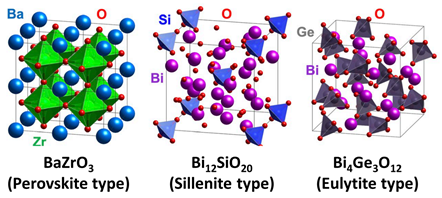Researchers at Kyushu University have created a framework that leverages machine learning to expedite identifying materials for green energy technologies in partnership with Osaka University and the Fine Ceramics Center.
 The proton-conducting layer currently found in solid oxide fuel cells is typically made from a perovskite structure (left). Using machine learning, a research team has identified two new materials with different crystal structures (center and right) that can also conduct protons. Image Credit: Kyushu University
The proton-conducting layer currently found in solid oxide fuel cells is typically made from a perovskite structure (left). Using machine learning, a research team has identified two new materials with different crystal structures (center and right) that can also conduct protons. Image Credit: Kyushu University
With the use of the novel strategy, the scientists were able to locate and successfully create two new candidate materials for use in solid oxide fuel cells, which are energy-generating devices that run on carbon dioxide-free fuels like hydrogen.
Their discoveries, which were published in the journal Advanced Energy Materials, may also hasten the hunt for further cutting-edge materials beyond the energy industry. As the planet warms, scientists are creating novel methods of producing energy without using fossil fuels.
One path to carbon neutrality is by creating a hydrogen society. However, as well as optimizing how hydrogen is made, stored, and transported, we also need to boost the power-generating efficiency of hydrogen fuel cells.
Yoshihiro Yamazaki, Professor, Department of Materials Science and Technology, Kyushu University
Solid oxide fuel cells must be able to effectively conduct hydrogen ions, also known as protons, through a solid substance called an electrolyte to produce an electric current. Currently, oxides with extremely particular atom crystal arrangements, known as perovskite structures, are the subject of research into novel electrolyte materials.
The first proton-conducting oxide discovered was in a perovskite structure, and new high-performing perovskites are continually being reported, but we want to expand the discovery of solid electrolytes to non-perovskite oxides, which also have the capability of conducting protons very efficiently.
Yoshihiro Yamazaki, Professor, Department of Materials Science and Technology, Kyushu University
However, using conventional "trial and error" approaches to find proton-conducting materials with different crystal structures has many drawbacks. Tiny amounts of an additional material, referred to as a dopant, must be added to the base material for an electrolyte to acquire the capacity to carry protons.
However, it becomes challenging and time-consuming to identify the ideal combination that improves proton conductivity since there are so many interesting base and dopant options, each with unique atomic and electronic properties.
Rather, the scientists computed the characteristics of several oxides and dopants. They then analyzed the data, determined the variables influencing a material's proton conductivity, and predicted possible combinations using machine learning.
The scientists then created two intriguing materials, each with a distinct crystal structure, and evaluated how well they carried protons, all under the guidance of these variables. Notably, in a single experiment, both materials showed proton conductivity.
The first known proton conductor with a sillenite crystal structure is one of the materials, the researchers noted. The high-speed proton conduction path of the other, with a eulytite structure, differs from the conduction paths observed in perovskites. These oxides do not work well as electrolytes at the moment, but the research team thinks that if they are studied more, they will become more conductible.
Our framework has the potential to greatly expand the search space for proton-conducting oxides and, therefore, significantly accelerate advancements in solid oxide fuel cells. It is a promising step forward to realizing a hydrogen society; with minor modifications, this framework could also be adapted to other fields of materials science and potentially accelerate the development of many innovative materials.
Yoshihiro Yamazaki, Professor, Department of Materials Science and Technology, Kyushu University
Journal Reference:
Fujii, S., et.al., (2023). Discovery of Unconventional Proton‐Conducting Inorganic Solids via Defect‐Chemistry‐Trained, Interpretable Machine Learning. Advanced Energy Materials. doi.org/10.1002/aenm.202301892.